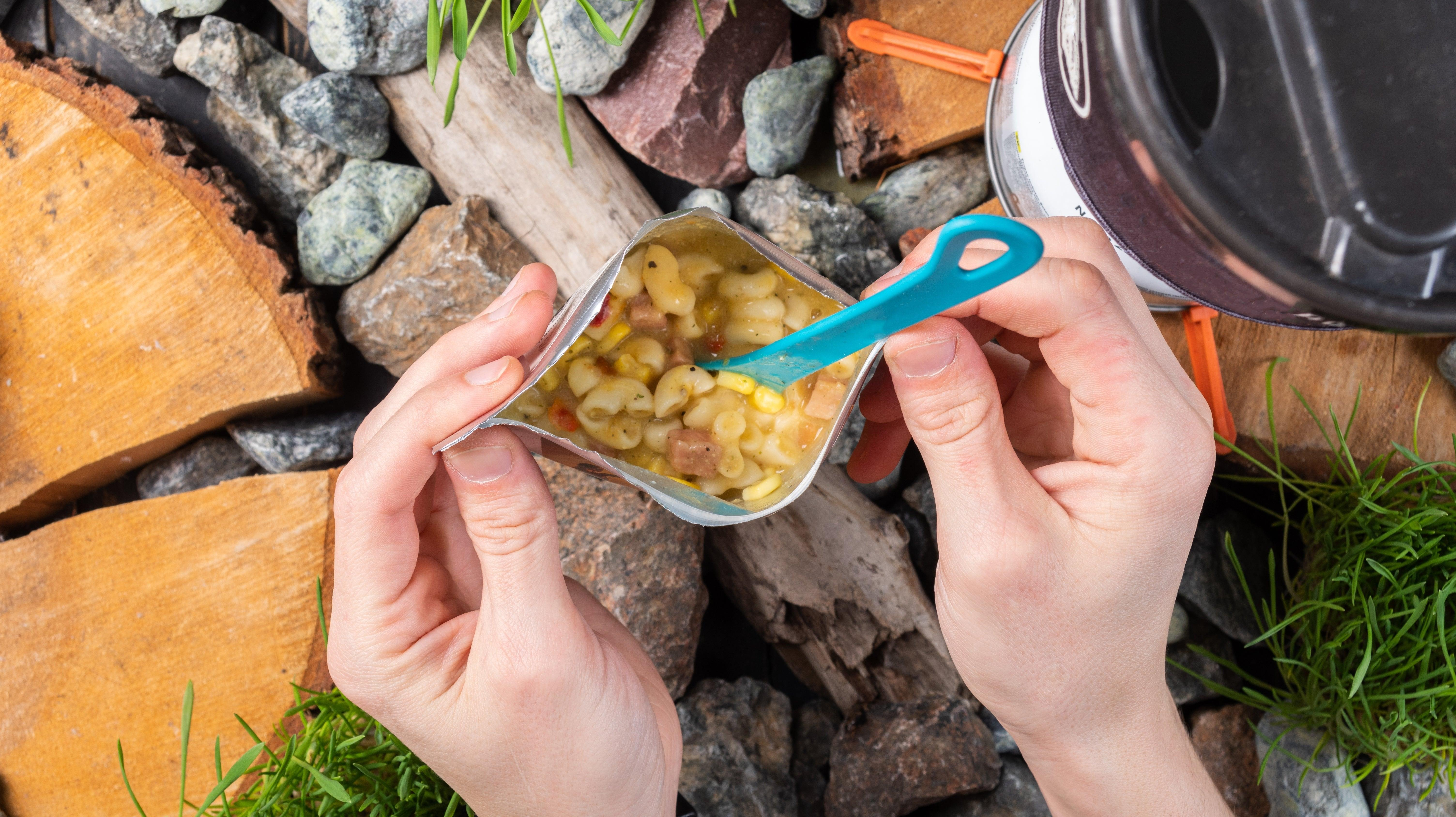Backpacking Food Has Never Been Better
You could be eating freeze-dried enchiladas on the trail as we speak.
Hear the words "backpacking food," and you probably think about stuff in cans: tuna, beans, maybe even Spam, anything that's already cooked, calorie-dense, and virtually nonperishable. And yet, if you're going on a backpacking trip for many days or even weeks, canned food actually presents a major logistical issue: it's heavy.
Depending on their body weight, backpackers typically carry around 25-30 pounds worth of supplies on their backs for multi-day trips, according to the site FarOut. That means that every ounce must be accounted for, especially because they're already packing a tent, sleeping equipment, and items like water filters and camp stoves. So how do experienced backpackers reduce the weight of their pack, and still bring enough food for multiple days?
What are backpacking meals?
Over the past few decades, backpacking meals—freeze-dried meals sold at outdoor equipment stores like REI—have become a backpacker staple. Weighing around 5 or 6 ounces per meal, often less, a backpacking meal already weighs significantly less than a can of beans, which typically clocks in at just under a pound (and much of which is water weight).
While backpacking food can technically be anything you bring to eat on the trail, the term "backpacking meals"—also called camp meals or trail meals—typically refers to the specific packaged variety available online and at stores like REI and Dick's Sporting Goods, which often have a designated section with dozens of meal options.
The history of backpacking meals
Backpacking meals have been around since at least the 1970s (companies began freeze-drying food in the 1950s). Some of the earliest backpacking meal companies, such as Mountain House and Backpackers' Pantry (two of the biggest companies making backpacking meals today) launched a line of freeze-dried meals marketed toward hikers spending days or weeks on the trail who wanted to reduce the weight of their load.
Since then, backpacking meals have become a way to eat (relatively) well on the trail without relying on meals you had to cook. All you have to do is boil water and pour it in the meal pouch.
"I've personally noticed big changes in backpacking food over the past 15-20 years or so," said REI Community user DannyBoy in response to a post by The Takeout. "[There] used to be few options that all tasted like cardboard. Now there [is] a rapidly expanding menu of cuisines available in backpack-friendly freeze-dried form, many of which are quite tasty!"
The best backpacking meals to try
These days, there are a ton of meal options, ranging from no-frills comfort foods like spaghetti with meat sauce to Indian red lentil stew. Favorites on the REI website include Chicken Alfredo Pasta by the brand Peak Refuel, which has a nearly five-star rating with 83 customer reviews ("creamy and delicious!" wrote one commenter); vegan Butternut Dal Bhat, also by Peak Refuel; and a Thai curry from the brand Good To-Go. On subreddits like r/trailmeals and r/backpacking, the brand Mountain House gets a frequent shoutout—particularly their Chili Mac meal.
"I swear I could eat Chili Mac every day, at home...forever," one user wrote.
Backpacking meals vs. M.R.E.s
So what, exactly, is the difference between backpacking meals and something like an M.R.E.?
To put it simply, M.R.E.s., or Meals Ready-to-Eat, require no preparation other than warming them up, of course, which can actually be done without boiling water (each M.R.E. contains a flameless heater). Backpacking meals do require a little bit of preparation—boil water, pour into the pouch, and wait for around 10 minutes.
Then there's the object of taste: M.R.E.s generally range in quality from serviceable to, well, terrible—The Takeout's Dennis Lee reported that even the pizza isn't very good. By comparison, backpacking meals seem to taste at least halfway decent.
M.R.E.s are also heavier than backpacking meals, on average: an M.R.E. entrée alone, without snacks and desserts, can weigh as much as 8 ounces, according to listings on sites like MRE Depot.
While it depends on the brand, backpacking meals tend to have a longer shelf life than something like an M.R.E. While M.R.E.s generally last up to five years if stored correctly, backpacking meals typically have a shelf life of seven years or more; some brands, like Mountain House, can even last for up to 30 years.
Disadvantages of backpacking meals
"The downsides of most freeze-dried meals is that even the tasty ones tend to be somewhat on the salty side," wrote REI Community user JohnnyontheAT. The high sodium content is also a sticking point for Reddit users like MacGyverism and The_Bokeh_Bloke.
To those with more discerning palates, the convenience of backpacking meals doesn't make up for the fact that they taste like, well, processed food.
"IMHO many are just kind of meh (or worse!)," wrote JohnnyontheAT.
Other food options for backpackers
While many backpackers still resort to bringing fresh or canned ingredients on the trail with them, others compromise by dehydrating meals from scratch, or by purchasing freeze-dried foods like meats and vegetables separately.
There's even a wealth of Reddit threads, blog posts, and YouTube videos devoted to the subject of DIY backpacking meals.
Whether you're a seasoned backpacker or someone hitting the trails for the first time, it's good to know that you've got a wealth of options for refueling after a long day's hike. However, while you certainly don't have to stock up on freeze-dried meals, there's something oddly comforting about the fact that you can eat cheese enchiladas with ranchero sauce on the Appalachian Trail. Modern technology truly knows no bounds.
